There is no real peak telephony.

[Chad Hart is no stranger to my readers here. He runs webrtcHacks, part of the Kranky Geek team and works at Voxbone. This time, he takes a look at telephony and where it stands today – with and without WebRTC]
Back in April of 2015, I recall Google WebRTC Product Manager Serge LaChapelle talking about the WebRTC team’s focus on mobile and how they wanted to kick “VoLTE’s butt”. To be fair he was referencing call connection times, but reading between the lines I like to believe he has had ambitions well beyond that – namely beating VoLTE and the traditional telephony network in minutes.
For many years I have tried to keep track of how the traditional telecoms has fared against the emerging VoIP application world (what they sometimes derogatorily call “OTT”). I have had two hypotheses for several years now:
- Traditional telecoms over the PSTN is past “peak” and will continue to decline
- Real time communications (RTC) in general has been on the decline but is poised to make a comeback thanks to better implementations and technologies like WebRTC
Let’s check the data to test these statements.
Peak Telephony? Maybe Not…
Digging into the statistics from various sources, I was surprised to find I was wrong about my first hypothesis on peak telephony.
The US market
Let’s start by taking a look at the situation in the US, one of the world’s largest communications markets. The Consumer Telecommunications Industry Association (CTIA) provides an annual update that sometimes includes Minutes of Use (MoU) and subscriber data. The data shows that on a subscriber-level, mobile telephony usage already peaked on a per-subscriber basis in 2007.
However, there is a growing number of data-only subscriptions for our tablets and other devices counted as subscribers. This negatively skews the numbers. Looking at “minutes” on a per capita basis is a cleaner metric, so let’s divide the minute figures by the US population. This shows a much more interesting picture where mobile phone usage for traditional calling actually went up by 16%.
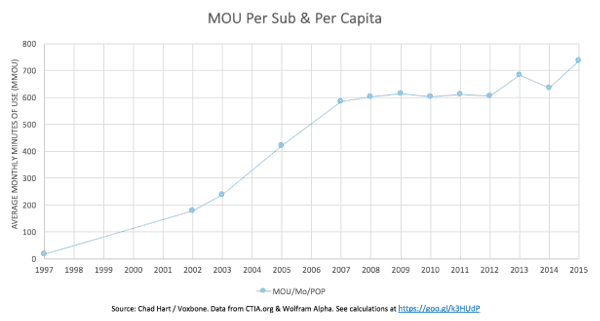
Total US cellular telephony minutes appear to be rising after stalling for many years (my calculations)
Checking the data against other FCC sources, this growth may be overstated but there is no clear evidence of decline. So what’s going on? Much of cellular’s continued volumes can be attributed to fixed-mobile substitution – both in terms of people dropping their fixed lines and as the FCC reports “A significant percentage of homes with both landline and wireless phone access received all or almost all calls on wireless telephones despite also having a landline telephone.” If we assumed total PSTN calling was flat, then according to my estimates, a 30% annual decline in fixed line minutes would be required to explain the decrease. This is possible, but way faster than past usage declines in fixed so it is more likely cellular usage did indeed have a very good year in 2015.
There is no clear evidence of peak PSTN telephony in the US, so let’s check some other sources.
The UK market
The UK’s Ofcom is generally a much better datasource than the FCC since they look at communications as a whole within the UK and compare it to other countries.
They are a lot more pessimistic when it comes to PSTN-based telephony. Their data is very definitive showing a continued, gradual decline in PSTN call volumes going back to 2010. With a -3% 5 year CAGR, no matter how you cut it, “operator” traffic is down.
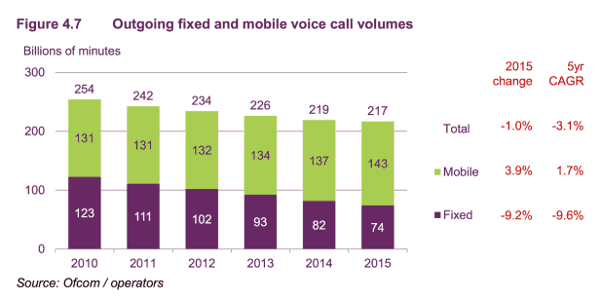
Ofcom CMR 2016 report shows declines in operator voice usage
They have not released their global figures for 2015, but their 2014 report showed similar trends with mature markets declining (US, Western Europe, Japan & Korea). However, emerging marketings like China, India, and Russia show show growth and just make up for declines in the mature markets in 2014.
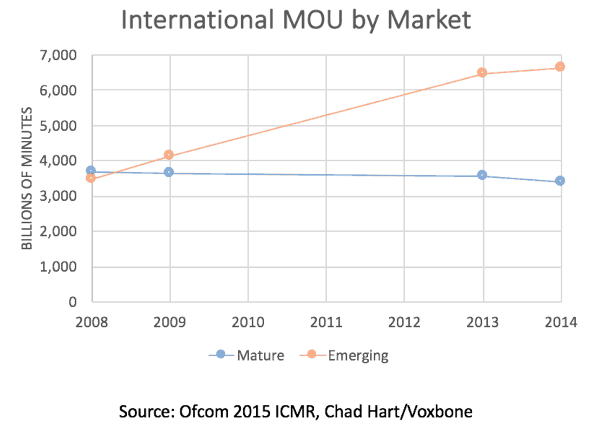
Does anyone care about the PSTN anyway?
Outside of adding touch tone dialing and going cordless, the Public Switched Telephone Network (PSTN) telephony user experience hasn’t exactly changed a whole lot in a hundred years. The PSTN is only one way to make calls – now we dedicated VoIP apps, messenger apps with voice, and a growing number of video communications options. Do these new forms for RTC give us any hope of reversing traditional telephony’s demise? The data here is more positive.
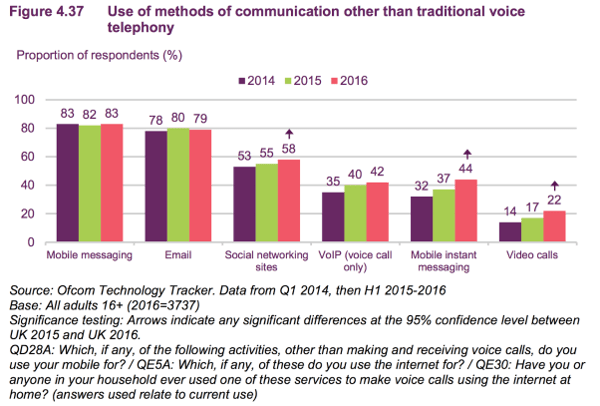
Ofcom’s data shows an increasing usage of VoIP for voice calls and a very definitive increase in video call usage. This is consistent with their international research from a year earlier:
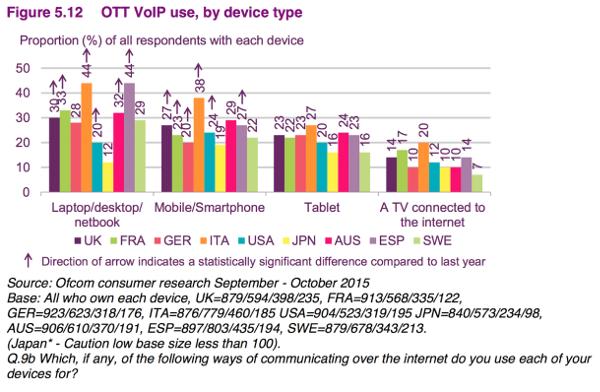
VoIP Apps Save the Day
So where do newer RTC apps and features fit into all this? Using Ofcom’s methodology, the 18 countries they track produce somewhere around 10 Trillion minutes a year. Microsoft has previously claimed Skype does up to 3 Billion minutes a day – that’s a Trillion minutes a year if one assumes around a 3 Billion daily average. Even if the true annual value is half of that, clearly Skype alone is meaningful compared to PSTN volumes.
Apple does not release any figures for its FaceTime service introduced in 2011, but presumably its usage is substantial, although less than Skype’s based on Ofcom’s past user surveys. WeChat, Line, and Viber all have more than 200 million monthly active users with various VoIP features. WhatsApp now has more than 1 billion MAU. Its VoIP calling feature launched in April 2015 has more than 100 million voice calls a day. Taken together, these other VoIP services are easily more than a trillion minutes a year.
At 10 to 20% of the PSTN’s volume, clearly VoIP traffic has a ways to go before it dominates the PSTN, but there is no doubt its volumes are meaningful in comparison. Furthermore, these services are still growing. Certainly some of that growth will come at the expense of the PSTN, but it appears they are also encouraging more RTC use in general.
Does WebRTC matter?
WebRTC does not factor heavily into the services cited above, but that is poised to change. At only 5 years old, WebRTC has not had that much time to widely establish itself in relation to other VoIP technologies. Still, there are a few notable standouts – particularly notably Facebook Messenger. Facebook has stated it has more than 300 million monthly active users of Messenger’s VoIP features and just this week announced it had 245 million monthly video users. Other notable users include Snapchat and of course Google’s Hangouts and Duo services.
There are a lot of other WebRTC apps showing big user gains too such as Houseparty which reported it had 20 million minutes of usage a day last month – not bad for an app that only emerged from the ruins of Meerkat a few months ago. In addition, more traditional VoIP apps like Whatsapp and Skype are starting to use WebRTC, albeit in limited circumstances today but that will certainly grow too.
In aggregate, I estimate WebRTC-based services easily have over 500 million MAU this year across 2 billion devices. Comparing this to other VoIP technologies at the 5 year mark, WebRTC is way ahead. This bodes well for WebRTC to be an incremental driver of VoIP traffic and further accelerator of RTC.
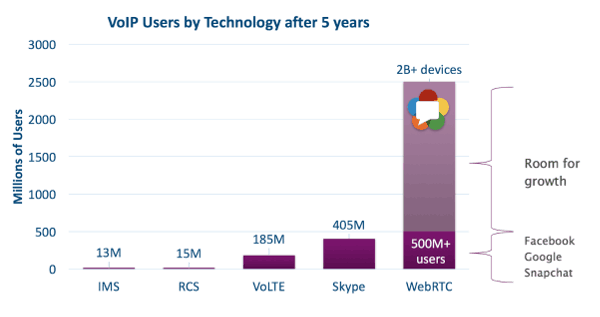
Conclusions
I have been concerned that the desire of people communicate in real time reached its pinnacle long ago. Why focus on RTC if the trend is clearly toward “messaging” and other forms of textual interaction? Has telephony peaked? The evidence suggests that is probably the case for the PSTN in developed markets, but there are plenty of pockets of growth. Where declines exist, they are gradual. Even better, there is a large body of evidence that VoIP services are more than making up the gaps of any declines and then some. This indicates that we are actually using real time communications more than even. The recent and rapid rise of many WebRTC services is a further shows that this trend is very likely to continue, or perhaps even accelerate. That’s great news for the hundreds of WebRTC vendors out there and those that have yet to come.

Excellent article with rich content in the trends occurring in the voice and OTT telecom space.